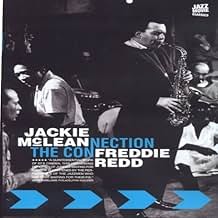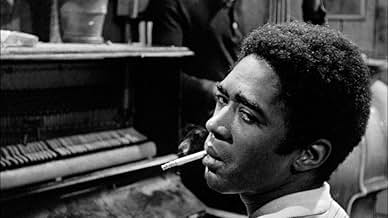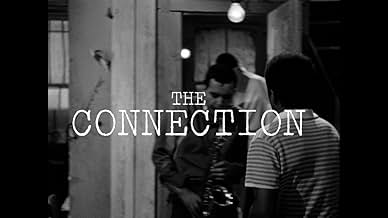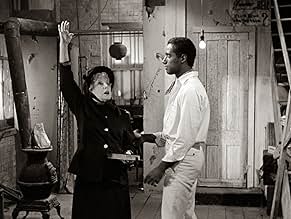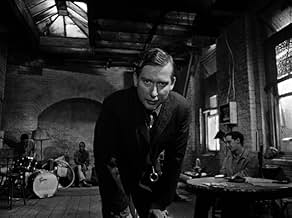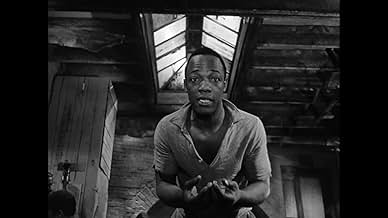IMDb-BEWERTUNG
7,0/10
1119
IHRE BEWERTUNG
Füge eine Handlung in deiner Sprache hinzuMen sent their own way await heroin in Leach's apartment.Men sent their own way await heroin in Leach's apartment.Men sent their own way await heroin in Leach's apartment.
Jerome Raphael
- Solly
- (as Jerome Raphel)
Jim Anderson
- Sam
- (as James Anderson)
Roscoe Lee Browne
- J.J. Burden
- (as Roscoe Browne)
Empfohlene Bewertungen
Jack Gelber's play, "The Connection" ran in London not long after its run in New York, with the same cast and same musicians. The film follows the play faithfully: it couldn't really be any other way. I much preferred the play, mainly because of its immediacy and its intimacy as the action unfolds right before your eyes, especially when the 'connection' arrives', and one by one, the players disappear into the bathroom. I don't for one second believe that the actors actually injected themselves, but on stage, the feeling is that they were doing just that. Don't get me wrong, Shirley Clarke's film of Gelber's play is a brilliant testament of how to make a film about a bunch of guys sitting around in one room (most of the time), waiting for their 'connection', without becoming bored or jaded. In fact, the film is on some levels, better than the play. For a start, if you are a fan of jazz and Jackie McLean in particular, you got to see lots close-ups of the band in full flight. Shirley Clarke was/is, one of the many underrated film directors around. If you liked "The Connection" (though 'like' isn't really the correct verb here), her documentary, "Portrait Of Jason" is another gem to seek out.
And what a stupid comment by a previous viewer. "Are all jazz musicians heroin attacks?" C'mon, there isn't a trend here, and perhaps you don't like jazz because you have no taste in music. Anyway, Shirley Clarke's cinema verite'style is put to the test , as we witness some sleazed-out New Yorkers in their subterranean dwelling, as they await their heroin "connection" -the mysterious Cowboy, played by Clarke's real-life lover, Carl Lee.
A remarkably tense and anxious little film about a group of junky musicians "waiting for their man" in a New York flophouse loft. They're joined by a documentary film crew (just a director and a cameraman) whose goal seems to be some sort of cinéma vérité about the life of junky musicians who wait in flophouse lofts.
After a few introductions, and comical "act natural" type instructions from the documentary director, the characters take turns addressing the camera. They nervously rant, philosophize, and insult each other, interrupted occasionally by improvised jazz from several legitimate musicians in the cast (most notably pianist Freddie Redd and tenor sax player Jackie McLean). The anxiety they feel as they wait for their fix is brilliantly conveyed by both the actors and the director (this time I mean the real director, Shirley Clarke, not the actor portraying the documentary director, got it?)
Much of this conveyed anxiety comes from the fact that the film is a strange and slightly unsettling mix of stark realism and stage acting (it is a filmed version of a play from the New York theater scene of the day). This is an unusual film and it honestly takes some getting used to, though probably less now taking into account the glut of nauseatingly self-conscious "mockumentaries" and hyper-stylized "reality shows" we are plagued with today.
The Connection is something different, matching edgy subject matter with edgy film-making the producers were working very much without a net. Consequently some might think it ends in disaster, I think it's a highly interesting experiment that's well worth watching.
After a few introductions, and comical "act natural" type instructions from the documentary director, the characters take turns addressing the camera. They nervously rant, philosophize, and insult each other, interrupted occasionally by improvised jazz from several legitimate musicians in the cast (most notably pianist Freddie Redd and tenor sax player Jackie McLean). The anxiety they feel as they wait for their fix is brilliantly conveyed by both the actors and the director (this time I mean the real director, Shirley Clarke, not the actor portraying the documentary director, got it?)
Much of this conveyed anxiety comes from the fact that the film is a strange and slightly unsettling mix of stark realism and stage acting (it is a filmed version of a play from the New York theater scene of the day). This is an unusual film and it honestly takes some getting used to, though probably less now taking into account the glut of nauseatingly self-conscious "mockumentaries" and hyper-stylized "reality shows" we are plagued with today.
The Connection is something different, matching edgy subject matter with edgy film-making the producers were working very much without a net. Consequently some might think it ends in disaster, I think it's a highly interesting experiment that's well worth watching.
Regular readers of my comments know I study folding, and I suggest that it is a deep concern for many filmmakers going back many decades. Most of my viewing these days comes from reader suggestions.
This is one, and very interesting. Group it with "The Saragossa Manuscript" as an early experiment, probably influential. Crude and obvious, but of historical interest.
I will describe it because it is hard to find.
Ostensibly it is a documentary drama, filmed of then contemporary jazz musicians (man, dig?) in a seedy apartment. They are there for their pooled money to turn into a pooled high, then pooled music. The thing is framed by a device: the film is made by two people, the director and a photographer. During the film, the director has his first hit of heroin, and presumably succumbs to it thereafter. The movie starts with a statement by the photographer that the director has abandoned the project and he (the photographer) has assembled it for us.
In what we call the real world, this is a play about this film-making. So to begin, it is a film about a play (a very obvious play) about a film about a "real" drama. A theory of theater at the time was that such abstraction and acknowledgment of the medium would allow the form of the reality to shine through.
It is the theatrical equivalent of an architectural notion that you can see in the Paris Museum called Pompidou, where all the structure is more than exposed, exposed in a way so obvious it is supposed to be invisible.
You may buy this. I certainly did when I was an architect in this era until I actually designed a building using it.
The difficulties of making this work are enormous.
You can see those problems here. Cowboy is the agent who brings the high. He arrives in pristine white, an articulate black man who used to be a musician and now is a savior. He brings an old woman, a salvation army warrior from 70 years earlier, incidentally 70 years old and worried about her burial.
For this, you need extremely clean images, touchstone dialog (where you jump from pad to pad without muddying yourself), and actors who understand all the folds and can inhabit them all.
This has none of that. These are street performers after the manner of "The Living Theater" which eschewed just the kind of thinking this project demands.
What we end up with is a bunch of actors with empty lives without layers who give us a layered story about a bunch of musicians with empty lives because they left layers behind.
You'll probably want to watch "Hurly Burly" for something like this done well, or this for historical interest.
Ted's Evaluation -- 2 of 3: Has some interesting elements.
This is one, and very interesting. Group it with "The Saragossa Manuscript" as an early experiment, probably influential. Crude and obvious, but of historical interest.
I will describe it because it is hard to find.
Ostensibly it is a documentary drama, filmed of then contemporary jazz musicians (man, dig?) in a seedy apartment. They are there for their pooled money to turn into a pooled high, then pooled music. The thing is framed by a device: the film is made by two people, the director and a photographer. During the film, the director has his first hit of heroin, and presumably succumbs to it thereafter. The movie starts with a statement by the photographer that the director has abandoned the project and he (the photographer) has assembled it for us.
In what we call the real world, this is a play about this film-making. So to begin, it is a film about a play (a very obvious play) about a film about a "real" drama. A theory of theater at the time was that such abstraction and acknowledgment of the medium would allow the form of the reality to shine through.
It is the theatrical equivalent of an architectural notion that you can see in the Paris Museum called Pompidou, where all the structure is more than exposed, exposed in a way so obvious it is supposed to be invisible.
You may buy this. I certainly did when I was an architect in this era until I actually designed a building using it.
The difficulties of making this work are enormous.
You can see those problems here. Cowboy is the agent who brings the high. He arrives in pristine white, an articulate black man who used to be a musician and now is a savior. He brings an old woman, a salvation army warrior from 70 years earlier, incidentally 70 years old and worried about her burial.
For this, you need extremely clean images, touchstone dialog (where you jump from pad to pad without muddying yourself), and actors who understand all the folds and can inhabit them all.
This has none of that. These are street performers after the manner of "The Living Theater" which eschewed just the kind of thinking this project demands.
What we end up with is a bunch of actors with empty lives without layers who give us a layered story about a bunch of musicians with empty lives because they left layers behind.
You'll probably want to watch "Hurly Burly" for something like this done well, or this for historical interest.
Ted's Evaluation -- 2 of 3: Has some interesting elements.
I don't know why anyone would call this realistic. It looks and feels like a play...the "acting", the overblown dialogue (almost Odets-like), etc. And unless you were a junkie in 1961, how would you know if it's realistic? And Sister Salvation? How could that possibly be real?! Noone is that clueless.
It's obviously dated for many reasons....the "lingo", the lack of serious profanity, the odd discussion of homosexuality.
Still, the film hooks you in...and I'm not exactly sure why. I guess it never really slows down. The camera tricks are cool, the band is great, some good dialogue. And the acting and characters are interesting, if not realistic.
Worth seeing...
It's obviously dated for many reasons....the "lingo", the lack of serious profanity, the odd discussion of homosexuality.
Still, the film hooks you in...and I'm not exactly sure why. I guess it never really slows down. The camera tricks are cool, the band is great, some good dialogue. And the acting and characters are interesting, if not realistic.
Worth seeing...
Wusstest du schon
- WissenswertesThis film was held up for release after the Board of Regents of the Motion Picture Division of New York State's Dept. of Education viewed the film and refused to grant it a license to be commercially shown. This was mostly due to the repeated use (seven times) of a four-letter word that rhymes with "hit" and is used as a slang synonym for heroin. The film was judged obscene but opened without a license anyway at the D.W. Griffith Theater on October 3, 1962, only to receive several bad reviews from the major N.Y. film critics. Director Shirley Clarke sued and a month later, the highest court in the state reversed the decision of the Board of Regents. However, the reputation of the film was already damaged and to this day, it has never recouped its original $167,000 budget.
Top-Auswahl
Melde dich zum Bewerten an und greife auf die Watchlist für personalisierte Empfehlungen zu.
- Where Can I Find This?
Details
- Erscheinungsdatum
- Herkunftsland
- Offizieller Standort
- Sprache
- Auch bekannt als
- La conexión
- Drehorte
- Produktionsfirmen
- Weitere beteiligte Unternehmen bei IMDbPro anzeigen
Box Office
- Budget
- 167.000 $ (geschätzt)
- Laufzeit1 Stunde 50 Minuten
- Farbe
- Seitenverhältnis
- 1.37 : 1
Zu dieser Seite beitragen
Bearbeitung vorschlagen oder fehlenden Inhalt hinzufügen


